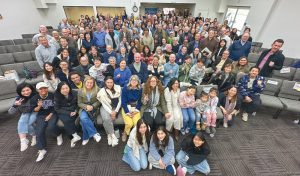At the Seikyo Shimbun Building, Ikeda Sensei (appearing as Shin’ichi Yamamoto in the novel The New Human Revolution) offers guidance about how elevating our life condition through Buddhist practice enables us to respond positively to life’s constantly changing realities. This excerpt can be found in The New Human Revolution, vol. 18, pp. 64–65.
Shin’ichi [Yamamoto] said: “When you’re at street level you cannot really see the layout of the surroundings, but when you observe it from above, it becomes quite clear. Buddhism is the path that enables us to establish an elevated life condition, from which we can calmly survey all.”
A philosopher of ancient times said, “When we consider the state and condition of [humankind], we should place our imagination upon some lofty pyramid, and from thence take a prospect of the world, and look it over as it were at one view.”[1]
Shin’ichi continued: “If you allow yourselves to be tossed about by the turbulent waves of society, you cannot perceive the direction that the times are moving in, nor can you do anything to change things. But by opening the eye of faith and raising your life condition, you can easily apprehend the reality of existence. That is one important meaning of the Buddhist teaching of ‘transcending the world.’ It does not, as you might think, mean simply separating yourselves from the world or abandoning it.
“By transforming your lives through faith, you will be able to respond flexibly and positively to the varied and constantly changing realities of life. Toward that end, it is important that you base yourselves on Nichiren’s writings and strive to polish yourselves.”
Transforming Suffering Into Joy and Ease
Ikeda Sensei (appearing as Shin’ichi Yamamoto in the novel The New Human Revolution) encourages members at the Tokyo No. 2 Headquarters women’s meeting. This excerpt can be found in The New Human Revolution, vol. 26, pp. 120–22.
“Nichiren often quotes the Lotus Sutra passage ‘living beings enjoy themselves at ease’ (The Lotus Sutra and Its Opening and Closing Sutras, p. 272). As this passage indicates, the purpose of our practice is to transform this life of pain and suffering into one of enjoyment and ease.”
Shin’ichi then stated that the means by which we can realize that transformation is chanting to the Gohonzon, and he went on to explain the principle underlying it. “When we chant Nam-myoho-renge-kyo to the Gohonzon—which is the embodiment of the life of Nichiren Daishonin, the Buddha of the Latter Day of the Law—our lives fuse with the great life state of the Buddha [Nam-myoho-renge-kyo].[2] As a result, we can manifest the Buddhahood inherent within us.
“That life state of Buddhahood is characterized by the four virtues of eternity, happiness, true self and purity. ‘Eternity’ means that the Buddhahood inherent within us is eternal and unchanging throughout the three existences of past, present and future. ‘Happiness’ is a state of ease and the absence of suffering. ‘True self’ is a strong life force that nothing can harm or destroy. ‘Purity’ refers to a life state of supreme purity and integrity.”
When our lives are permeated by the four virtues of eternity, happiness, true self, and purity, we can spend our days calmly, enjoyably, and without fear, no matter what happens.
Shin’ichi explained that “joy and ease” in Buddhism does not refer to such relative conditions as mere wealth, status, fame, ability or health. He said that it refers to a deep sense of joy and fulfillment, a state of absolute happiness.
He said: “I’m sure there are times you wish, for example, that your husband’s salary was a little higher, your house was a little bigger or your children’s grades in school were better. It is important to chant and strive to fulfill such goals. The most important thing, however, is to build a life state in which you won’t be defeated or discouraged, no matter how great the trials and tribulations you encounter.
“Even if you should end up losing everything you own, fall seriously ill or lose someone dear to you—having the strength to overcome all misfortune and build a happy life constitutes ‘joy and ease.’
“Nichiren Daishonin wrote, while on Sado, where his very life was in constant danger: ‘I feel immeasurable delight even though I am now an exile’ (“The True Aspect of All Phenomena,” WND-1, 386). Establishing such a lofty life state is the real aim of our Buddhist practice. That’s why it is vital to have the courage to confidently face even the most daunting hardships for the sake of kosen-rufu. Without courage, you cannot experience indestructible joy and ease.”
References
- Marcus Aurelius, The Meditations of Marcus Aurelius, trans. Jeremy Collier (London: Walter Scott, n.d.), 114. ↩︎
- Our lives fuse with the great life state of the Buddha. The fusion of the objective reality or truth and the subjective wisdom to realize that truth, which is the Buddha nature inherent within one’s life. Since enlightenment, or Buddhahood, is defined as the state in which one fully realizes the ultimate reality, the fusion of reality and wisdom means enlightenment. ↩︎
You are reading {{ meterCount }} of {{ meterMax }} free premium articles





